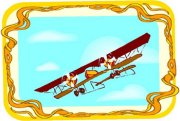
Worksheets and No Prep Teaching Resources
Reading Comprehension Worksheets
Transportation

Transportation
 Worksheets and No Prep Teaching Resources Reading Comprehension Worksheets Transportation |
 Transportation |
| edHelper's suggested reading level: | grades 5 to 7 | |
| Flesch-Kincaid grade level: | 9.99 |
|
Evolution of the Airplane
By Trista L. Pollard |

|
 1 Since that fateful day in December of 1903, airplane design has changed dramatically. The Wright Brothers built a biplane with two propellers that were chain-driven by a gasoline motor. Their first engine weighed a whopping twelve pounds (5.4 kilograms) per horsepower. Today's airplanes have engines that weigh one pound or less per horsepower. They also use shorter wings because they depend less on the lift that is produced by those wings. Our dependence on air travel over the years has forced airplane design to catch up with the times.
1 Since that fateful day in December of 1903, airplane design has changed dramatically. The Wright Brothers built a biplane with two propellers that were chain-driven by a gasoline motor. Their first engine weighed a whopping twelve pounds (5.4 kilograms) per horsepower. Today's airplanes have engines that weigh one pound or less per horsepower. They also use shorter wings because they depend less on the lift that is produced by those wings. Our dependence on air travel over the years has forced airplane design to catch up with the times. |
Create Weekly Reading Books
Prepare for an entire week at once! |
| Leave your feedback on Evolution of the Airplane (use this link if you found an error in the story) |
 |
Transportation
|